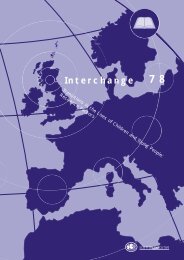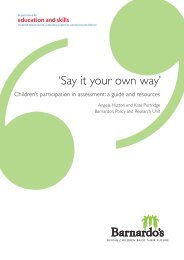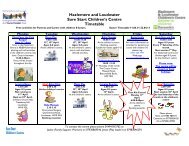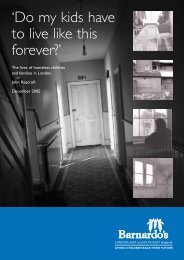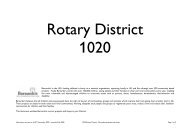Splintered Lives - Barnardo's
Splintered Lives - Barnardo's
Splintered Lives - Barnardo's
Create successful ePaper yourself
Turn your PDF publications into a flip-book with our unique Google optimized e-Paper software.
Child prostitution<br />
�� having to limit/control their sense of shame and/or humiliation in order to do it;<br />
�� having to 'expose' themselves in order to work;<br />
�� knowing that it is their vulnerability, the fact that they are a child, which is<br />
'attractive' to punters;<br />
�� cutting off from their own emotional responses, and the shame of sexual abuse<br />
being replaced and/or overlaid by the stigma of sex work.<br />
Some commentators have suggested that it is harder for children and young people<br />
who have been sexually exploited, especially those involved in prostitution, to see<br />
themselves as victims, since they 'seek' custom. However, we know from children and<br />
adults who have experienced other forms of sexual abuse that abusers often go to great<br />
lengths, and are very successful, in making children take on responsibility for the<br />
abuser's behaviour. On the other side one defence against feeling totally powerless is to<br />
create a version of reality in which one believes there are other options. The logic of this<br />
position is that one has chosen, and is therefore, responsible for sexual exploitation.<br />
Whilst this is form of 'dissassociative defence' (Herman, 1994), for some children/young<br />
people there is a form of 'choice' involved; in the face of minimal or no other options<br />
they choose sexual exploitation for which they get paid rather than personalised sexual<br />
abuse done in the name of love.<br />
Both the conditions of sexual exploitation and the ways children and young people find<br />
to survive it can result in them being unwilling, and at times unable, to talk about their<br />
experiences. They are frequently seen and/or treated as 'unco-operative' witnesses in<br />
investigations, where professionals have limited understanding of the issues involved.<br />
The research evidence to date<br />
Wolpert Burgess et al (1984) have explored in some detail the impacts on children<br />
involved in sex rings, and theirs is the most substantive work to date which we can<br />
draw on. In this series all the rings used pornography, and it was produced in over two<br />
thirds of them. Some aspects of the rings have strong parallels with prostitution, and<br />
several were involved in commercial child prostitution. Part of the entrapment process<br />
involved the recognition and temporarily fulfilment of children's emotional and physical<br />
needs. The fact that this is the case often results in strong ambivalence amongst<br />
children/young people.<br />
Interviews were conducted with the children and their parents/carers two years after<br />
disclosure. All of the children had very strong traumatic responses including: intrusive<br />
thoughts, flashbacks, vivid memories and dreams; almost all became increasingly<br />
isolated and withdrawn from others. Other 'symptoms' reported two years later for<br />
many included: hyperalertness; aggressive behaviour; and 'hypermasculine risk taking'<br />
PAGE 55<br />
chapter<br />
8






